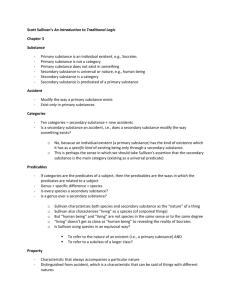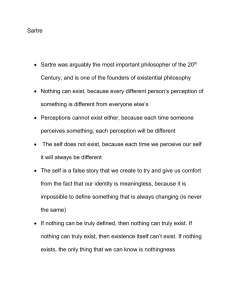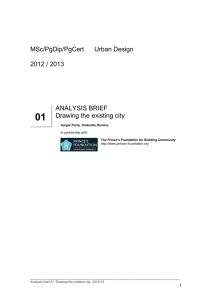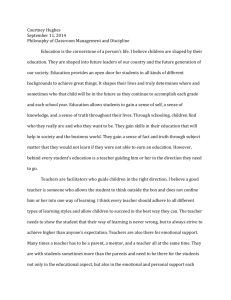BP08 L24 (final)
advertisement
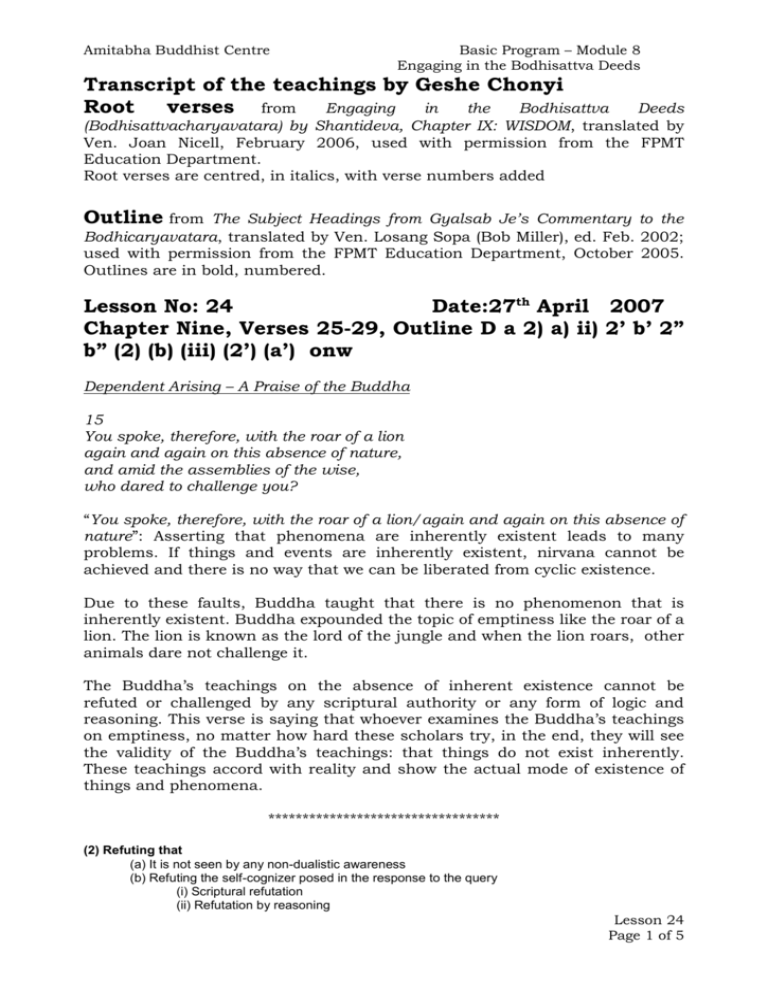
Amitabha Buddhist Centre Basic Program – Module 8 Engaging in the Bodhisattva Deeds Transcript of the teachings by Geshe Chonyi Root verses from Engaging in the Bodhisattva Deeds (Bodhisattvacharyavatara) by Shantideva, Chapter IX: WISDOM, translated by Ven. Joan Nicell, February 2006, used with permission from the FPMT Education Department. Root verses are centred, in italics, with verse numbers added Outline from The Subject Headings from Gyalsab Je’s Commentary to the Bodhicaryavatara, translated by Ven. Losang Sopa (Bob Miller), ed. Feb. 2002; used with permission from the FPMT Education Department, October 2005. Outlines are in bold, numbered. Lesson No: 24 Date:27th April 2007 Chapter Nine, Verses 25-29, Outline D a 2) a) ii) 2’ b’ 2” b” (2) (b) (iii) (2’) (a’) onw Dependent Arising – A Praise of the Buddha 15 You spoke, therefore, with the roar of a lion again and again on this absence of nature, and amid the assemblies of the wise, who dared to challenge you? “You spoke, therefore, with the roar of a lion/again and again on this absence of nature”: Asserting that phenomena are inherently existent leads to many problems. If things and events are inherently existent, nirvana cannot be achieved and there is no way that we can be liberated from cyclic existence. Due to these faults, Buddha taught that there is no phenomenon that is inherently existent. Buddha expounded the topic of emptiness like the roar of a lion. The lion is known as the lord of the jungle and when the lion roars, other animals dare not challenge it. The Buddha’s teachings on the absence of inherent existence cannot be refuted or challenged by any scriptural authority or any form of logic and reasoning. This verse is saying that whoever examines the Buddha’s teachings on emptiness, no matter how hard these scholars try, in the end, they will see the validity of the Buddha’s teachings: that things do not exist inherently. These teachings accord with reality and show the actual mode of existence of things and phenomena. ********************************** (2) Refuting that (a) It is not seen by any non-dualistic awareness (b) Refuting the self-cognizer posed in the response to the query (i) Scriptural refutation (ii) Refutation by reasoning Lesson 24 Page 1 of 5 Amitabha Buddhist Centre Basic Program – Module 8 Engaging in the Bodhisattva Deeds (iii) Refuting the syllogism [that asserts] the existence of a self-cognizer (1’) An example illustrating the production of memories despite the lack of a selfcognizer (2’) Refuting [the position that says] .If there is no self-cognizer, it is untenable for there to be a cognizer of others. (a’) The actual (b’) Refuting that very illusion from mind and its inexpressibility to others (iv) Refuting the position that holds imputed existents to be possessors of truly established supports for functioning things (a’) The actual (9, 25) [Madhyamaka ]: Just seeing, hearing, and knowing Are not what are negated here. Here it is that which causes suffering – The conception of them as truly existent – that is to be averted. The MOS assert that all phenomena exist truly. The MWS assert that all phenomena (both objects and subjects) do not exist truly. The counterargument from the MOS is that if things do not exist truly, there is no way that our eye consciousnesses can see forms, our ear consciousnesses can hear sounds and our minds can understand things. If things are not truly existent, there is no way they can function like that. Qualm from the MOS: The CMWS does not assert self-knowers because they maintain that the consciousness cannot illuminate or experience itself. If that is the case, that means the consciousness is also unable to illuminate or experience another consciousness which negates the existence of an other knower. If there is no other knower, it would not be possible to posit an eye consciousness that sees, an ear consciousness that hears and so forth. Response from the CMWS: “Just seeing, hearing, and knowing/Are not what are negated here.” The CMWS clarifies that they are not refuting that the ear consciousness hears sounds, the eye consciousness sees forms and the mental consciousness is able to know things. These things exist conventionally but, on their own, are insufficient to cause us suffering. “Here it is that which causes suffering - /The conception of them as truly existent – that is to be averted”: The CMWS refutes the conception which grasps phenomena as existing in the way they appear to our minds. Our consciousnesses perceive phenomena as existing from their own side and believe they exist like that. This is the root of all our suffering. (b’) Refuting that very illusion from mind and its inexpressibility to others (9,26) [Chittamatra ]: The illusory are not other than the mind yet They are also not considered to be other. Lesson 24 Page 2 of 5 Amitabha Buddhist Centre Basic Program – Module 8 Engaging in the Bodhisattva Deeds [Madhyamaka ]: If it is a thing, how could it not be other? Stating “It is not other,” it would not exist as a thing. (9,27) Just as the illusory are not truly existent but are viewed, Likewise [the mind] is that which acts to view. The MOS asserts that there are no external objects. Objects appear to exist externally as separate entities from the mind but, in reality, this is not how they exist. They are not of a different substance from the mind itself, yet they are not the mind. “The illusory are not other than the mind yet/They are also not considered to be other.” As stated in the outline, form is inexpressible. The MOS asserts that forms are truly existent. In their presentation of the basis of reality, anything that exists can be subsumed into three natures:1. other powered nature 2. thoroughly established nature 3. imputational nature Other powered nature and thoroughly established natures are truly existent. Only imputational nature is not truly existent. Form is truly existent because it is other powered nature. Response from the CMWS: The MOS asserts that forms are truly existent. This means that forms must exist exactly in the way they appear to the mind. Since forms appear as external objects, therefore, external objects exist. If external objects exist, they exist as separate entities from the mind and are not mind. If the MOS were to insist that form is not a different entity from the mind, the fault would be that the consciousness apprehending that form also cannot be truly existent. “If it is a thing, how could it not be other?/Stating “It is not other,” it would not exist as a thing.” The MOS holds that form which appears as an external object is a falsity. If that is so, then the consciousness apprehending that form also cannot be truly existent since the MOS also asserts that the form and the consciousness apprehending it cannot be of different substances. The fundamental assertion of the MOS is that consciousness is truly existent. That is why they assert self-knower. If consciousness is not truly existent, then there will a fault with the presentation of the perceiver and the perceived object. In the system of the CMWS, the illusory-like form which appears as the external object and does not exist truly can be conventionally posited as form, the object to be perceived. Likewise, the mind is not truly existent, but it can Lesson 24 Page 3 of 5 Amitabha Buddhist Centre Basic Program – Module 8 Engaging in the Bodhisattva Deeds be conventionally posited as the perceiver. “Just as the illusory are not truly existent but are viewed,/Likewise [the mind] is that which acts to view.” (iv)Refuting the position that holds imputed existents to be possessors of truly established supports for functioning things (9, 27 cd) [Chittamatra ]: Cyclic existence has as its support that which is a thing, Otherwise it would be like space. (9,28) [Madhyamaka ]: If that which is not a thing depends on a thing, How can it have a function? Your mind would be alone Without companions. (9,29) If the mind were free from apprehendeds Everyone would be a tathagata. If so, what quality would there be In considering there to be mere mind? According to the MOS, phenomena are either substantially existent or imputedly existent. Whatever is an imputed existent necessarily has a base (support). This base is substantially existent and is truly existent. For example, a person is an imputed existence who necessarily relies on substantial existence as a base (support). That support is the mind-basis-ofall of the person. To the MOS, the illustration of a person is the mind-basis-ofall. To the MOS, subject and object appearing as different entities are mistaken appearances. The supports for cyclic existence and mistaken appearance are truly existent. To the MOS, if a phenomenon such as cyclic existence does not have a truly existent basis (support), then it will be like space, unaffected by any kind of causes or conditions. It means functioning things become permanent or uncomposed phenomena in which case, there will be no way out of cyclic existence. Response from the CMWS: The MOS asserts that, for liberation from cyclic existence to be possible, imputed existents, like cyclic existence, need to depend on truly existent phenomena as their support. But if that which is not a thing depends on a thing, how can it have a function? Since the MOS asserts that consciousness is truly existent, that consciousness which is the basis for cyclic existence has to be inherently one and it cannot possess any parts. If that is case, how is liberation from cyclic existence possible?? Lesson 24 Page 4 of 5 Amitabha Buddhist Centre Basic Program – Module 8 Engaging in the Bodhisattva Deeds The MOS asserts that the basis of cyclic existence is the truly existent consciousness. If consciousness is truly existent, that means that the mind has always existed alone and was not accompanied by cyclic existence. That mind will be free of stains or faults, which means that all sentient beings are already buddhas. If that is the case, what is the purpose of developing all the arguments to prove that everything is in the entity of mind and that things do not exist as separate entities from the mind? In summary: For the MOS, an imputed existent such as person or cyclic existence must necessarily depend on a support which has to be a truly existent functioning thing. If the support is not a truly existent functioning thing, that imputed existent will not be valid. The CMWS argues that if the imputed existent such as person or cyclic existence were to depend on a truly existent functioning thing as its support, then liberation from cyclic existence could not be achieved. To the MOS, the person is an imputed existent and its support is the truly existent functioning thing, the-mind-basis-of-all. If the mind-basisof-all is truly existent, it has to be inherently one and not posses any parts. If that is the case, that mind cannot possess any stains or faults. This means all sentient beings are buddhas. Because of this problem, the CMWS says the basis for the support of the person has to be a functioning thing that is not truly existent. This is the same logic expressed in Nagarjuna’s “Fundamental Treatise on Wisdom” which says, “If everything is empty, everything is possible. If everything is not empty, nothing is possible.” Translated by Ven. Gyurme Transcribed by Phuah Soon Ek, Vivien Ng & Angie Xiao, 2nd May 2007 Edited by Cecilia Tsong, 2nd May 2007 Vetted by Geshe Chonyi Checked by Yap Siew Kee, 8th May 2007 Lesson 24 Page 5 of 5
